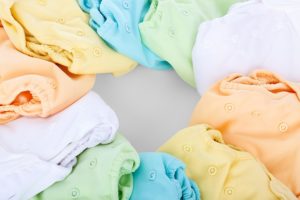Babies have worn cloth diapers for many years, and for good reason. Today, the use of traditional diapers has become a subject of debate in many households given the environmental and financial impacts, but there are still many benefits. and this article will look at some of the benefits of using cloth diapers.
What are the benefits of cloth diapers?
The use of cloth diapers has several advantages over traditional disposables, and the use of cloth diapers is becoming more popular in many countries.
Environmental impact
According to the EPA, disposable diapers are the third largest consumer item in landfills, and each year about 1.1 million disposable diapers are tossed into landfills. When they are thrown away, they do not degrade quickly because of their plastic backing. The chemicals from these non-degradable materials then leak into our soil and groundwater.
The average baby will go through nearly 5000 diapers during his first two years of life. That is the equivalent of filling over 2,800 trash bags with used diapers per child. Also, these items are not recyclable and can only be composted.
Cloth diapers are much more resource-efficient than disposables and can be used for years while saving money through waste reduction. Cloth diapers also do not require as many cleanings as disposables. Studies show that disposable diaper users typically change their diapers two to five times a day, while cloth diaper users change their diapers three to four times a day with the frequency increasing with age.
Costs
Disposables are very expensive. In some cases, some brands can cost $1 per diaper. These items can also be costly when considering the loss of municipal water, sewer and disposal costs, as well as costs for trash collection and composting services.
Prices range from around $0.30 to $2 per disposable diaper depending on the brand sold in different countries around the world. Disposable diapers are also very bulky and do not have access to all of the absorbent materials that can be used in cloth diapers to create absorbency, therefore making them less environmentally friendly than reusable cloth options.
Cloth diapers are much more economical than disposables. Though some may argue that the cost of cloth versus disposable is negligible, even with an increase in water and electricity, cloth diapers are still a more economical option.
There are many options for reusing cloth diapers, which can cut non-disposable diaper costs in half or even in fourths. Many families use diaper services so they can further cut costs on their diapering needs. Marketplaces also exist for parents to sell their used cloth diapers.
Baby skin irritation
The chemicals in disposables are the leading cause of diaper rash, and nearly all disposable diapers contain chlorine to kill bacteria. Cloth diapers do not use chlorine-bleached diapers and are made from all-organic materials.
Many children develop rashes or allergies due to the chemicals used in disposable diapers that are stored against the baby’s skin for extended periods of time. Cloth diapers do not have these problems since they are not stored against the baby’s skin and they absorb moisture from urine and feces better than disposables.
If you can use cloth vs. disposable, you are likely already using the cloth diapering system. There are many different kinds of cloth diapers to choose from (e.g. prefolds, or inserts), but there are very few chemical-free diaper brands that meet your needs.
However, there are many options made from cotton and hemp for those that wish to use all-natural material for their child’s diapers. Many new brands continue to be introduced in different materials like bamboo or water-resistant wool, which will be discussed in our opinion section.
Increased safety and comfort
Disposable diapers can irritate and cause swelling on a baby’s skin due to harsh chemicals used to preserve their shape. This can lead to rashes and skin irritations. In addition, the traditional diaper is often worn out by the time a baby is ready to be potty trained, which can increase costs and reduce convenience for parents.
The traditional diaper is also not the best long-term solution because they do not absorb very much liquid – meaning that it’s easy for urine and feces to leak onto a baby’s clothing.
Cloth diapers on the other hand are designed to stay in place because of their absorbent qualities, making them more comfortable for your child and easier for you to use. They also protect a baby from harmful bacteria by absorbing moisture so they don’t get red rashes or other skin infections.
You can also save hundreds of dollars by using reusable cloth diapers for your baby. Consider the average cost of disposable diapers to be about $3 per diaper and the cost of cloth diapers will be approximately $0.20 per diaper or about $80 per year. If you have more than one child, it only takes 31 years to save over $200 on disposables vs. the cost of purchasing the cloth diaper service or buying your own cloth diapers on a monthly basis for one child!
Final Thoughts
Using cloth diapers versus disposable diapers is a win-win solution because it’s better for you and your baby. You can easily save money by making the switch, and it protects your child from harsh chemicals that can cause diaper rash. Cloth diapers are also more comfortable for your child than disposables.
Many of these benefits may not be noticeable in the short term by using cloth diapers but are very noticeable over time. There are no real negatives to using cloth diapers besides set up time and rolling up a diaper to put it into the washer or dryer.

As a mother of four very energetic children, Emilia knows how chaotic motherhood can be. She’s learned a lot of lessons along the journey so far and loves sharing the tips & tricks she’s picked up over the years with anybody else on the same life path.

